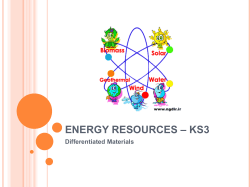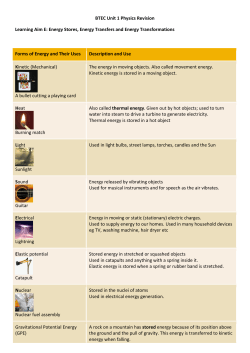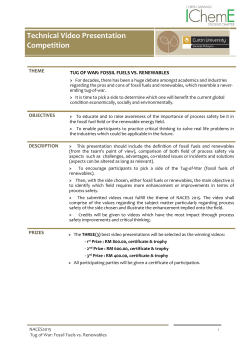
5-e classroom stem activity: sustainable living
5-E CLASSROOM STEM ACTIVITY: SUSTAINABLE LIVING - DESIGNING AN ENERGY-EFFICIENT HOUSE Dr. Candace Walkington, Assistant Professor of Mathematics Education Southern Methodist University ENERGY // KEEPING THE WORLD TURNING WHAT DOES THE FUTURE OF ENERGY LOOK LIKE? FUEL CELLS Hydrogen fuel cells produce electricity using hydrogen and oxygen. Because they are pollution free, fuel cells seem like they would be a perfect source of energy. However, although hydrogen is the most abundant element in the universe, most of it is bound up in molecules. Separating hydrogen from other molecules requires the use of fossil fuels in many cases. Another problem with hydrogen is that it cannot be compressed easily. If scientists can find a way to capture pure hydrogen and store it safely, fuel cells could be very useful. Chemists, all kinds of engineers and power plant operators are needed in this growing industry. SOLAR Energy from the sun had a big year in 2014 and is continuing to grow. According to the Solar Energy Industries Association, the growth through three quarters represented 36 percent of all new electricity capacity compared to only 9.6 percent in 2012. Germany produced half of its daily electricity demand from solar power on one sunny day this past summer. Solar energy has been used to aid in transportation, agriculture, water treatment and heating. From installing solar structures to researching uses, a job in solar energy offers tremendous opportunities for workers from all backgrounds. What if We Run Out of Fossil Fuels? BY STEPHANIE PETIT We rely on fossil fuels like gas, coal and oil to do everyday things like heat our homes, drive our cars and turn on our lights. Some estimates suggest we have as little as 70 years before these fossil fuels are gone, but even if we have much longer, gas, coal and other fossil fuels are going to run out eventually. What does the future of energy look like? Here are some of the resources scientists are looking into as options to keep our lights on. 10 WINTER 2015 // STEMJOBS.COM No “T , it w he W on’t alk be ing lik De e ad ”. WIND Wind power continues to be utilized and expanded. Larger turbines than ever before are being developed. This growth in turbine size enables the repowering of existing wind farm sites and the proposal of large new off-shore farms. In addition, carbon fiber kites with wind turbines claim to produce as much power as a fixed turbine, but with a much smaller cost of material. As the industry grows, the demand for technical expertise is needed, as well as experience in areas such as PR, community liaison and environmental impact. WAVES Like wind, waves are considered a “free” energy because they occur naturally. Now their power is being researched and used as a source of energy. Waves may even be better than wind because they are more predictable. In Scotland, the world’s biggest “wave farm” was approved this year and could power over 30,000 homes. Engineers are needed to install and perform maintenance on the incredible technology needed to harness wave power such as Oscillating Water Columns, which capture wave energy by harnessing air that is displaced by the waves. BACTERIA Bacteria like E. coli—usually responsible for making people sick—might have a practical energy use. British scientists have bioengineered E. coli to produce a hydrocarbon molecule that acts like petroleum oil. Many hurdles remain to scaling up these engineered bacteria, but the researchers believe it could be a viable alternative to producing ethanol from food crops. 5-E CLASSROOM STEM ACTIVITY: SUSTAINABLE LIVING Here are some ideas for how high school teachers could use this story as a launching point for integrated STEM learning. Our activities follow the 5-E Learning Cycle Model, and the activity below is intended to last three to four 1-hour class periods (although portions of the activity could be used in shorter time periods). Part 1: Engage 1 2 3 4 5 6 Read the STEM Jobs SM article “What if We Run Out of Fossil Fuels?” Ask students: What does the term “sustainable” mean to you? Write down students’ ideas on the board. Have you ever heard of an “Earthship”? What about the “tiny house” movement? Have the class watch the video: growingagreenerworld.com/sustainable-living. Discuss with the class: What do you think about the Earthship concept? Would you want to live in an Earthship? Why or why not? Would you want to live in a “tiny house”? Have students explore images of sustainable houses online: gizmag.com/gizmag-top-10-sustainable-innovative-green-houses/34712. Discuss: What things do you do at your house right now to promote sustainable living? hat could you do better hat are the benefits of sustainable li in hat are the drawbacks Part 2: Explore Place the students in engineering design groups of 4. Give groups the following task: This week, your group is going to be part of a design competition to design a sustainable home to be built in our city. You are responsible for researching the different aspects of sustainable home design, and then coming up with a plan for building your “dream” sustainable house. A good plan for a sustainable house won’t try to do everything that can possibly be done; rather it will balance the most important elements of sustainability with financial cost, safety and physical space. Some factors to consider: 1) The climate and weather patterns of your city 2) Insulation and flooring that will allow for efficient heating and cooling 3) Shape of the house and the ratio of volume to surface area, as well as the total square footage 4) Placement and type of windows, including issues of overhang, air flow and natural lighting 5) Use of sustainable materials to construct the house 6) The way in which water is brought into the home and heated 7) How trash is disposed of 8) How outside plants can be optimized to minimize energy and water usage 9) How power is provided to the house, including sustainable energy sources like solar panels or wind turbines 10) How sewage is disposed of/how toilets are designed 11) The placement of rooms with different functions in different parts of the house 12) Growing food and/or wildlife habitats Some useful websites to get started: sustainablebuild.co.uk • earthship.com susdesign.com • epa.gov/greenhomes 1 STEMjobs.com ustainable i in - esi nin an ner y- fficient ouse Work together to come up with a set of scale drawings showing the floorplan of your sustainable house (be sure to indicate which direction is north). Calculate the total square footage of the house, and list any major materials that would need to be purchased (e.g., solar panels). Also show how the outside/yard space will be utilized, and use elevation drawings to show how windows will be placed. You may also—if relevant—include cross-sectional drawings. Part 3: Explain Each group should present their plan for their sustainable home. Some questions to ask groups as they present include: 1 ow is your home ener y efficient ow will you minimi e heatin coolin costs 2 What properties of the environment in your city did you take into account when designing your home? 3 ow will you minimi e costs for water and sewa e 4 hat materials will you utili e when constructin the house What do you imagine the largest costs for building the house are? 5 hy did you decide to make a house of that particular si e and shape o you ha e an estimate of what the cost per square footage might be for your house? Do you have an estimate of what your monthly water ener y trash bill would be 6 What ideas that other groups who presented before you use that you liked? 7 hat do you think is special uni ue about your sustainable home Part 4: Elaborate 1 2 3 4 Have each group return to their original plan and modify it based on the other groups’ plans they saw presented and the class discussion around these plans. a e roups create a final oor plan. a e roups also calculate an approximate cost of buildin their final home, based on their materials list, and con ert this total cost into a cost per s uare foot. omes should ideally be desi ned to be net ero, meaning that they create as much energy as they use. Have students use a mortgage calculator (zillow.com/mortgage-calculator) to estimate how much their home would cost each month for their mortgage payments, over different lengths of time. a e students use the elements abo e to create a simple brochure or ier for sellin their sustainable home. Part 5: Evaluate Have students work on the following task individually in their science journals: What does “sustainable” mean to you? Why is sustainability important? What are the risks if humans don’t start building sustainably? What impact are humans having on the environment? What are some of the major challenges in sustainable design? Next Generation Science Standards: - . aluate or refine a technolo ical solution that reduces impacts of human activities on natural systems. - . aluate a solution to a complex real-world problem based on prioriti ed criteria and trade-offs that account for a range of constraints, including cost, safety, reliability and aesthetics as well as possible social, cultural and environmental impacts. 2 STEMjobs.com ustainable i in - esi nin an ner y- fficient ouse STEMjobs.com
© Copyright 2025














